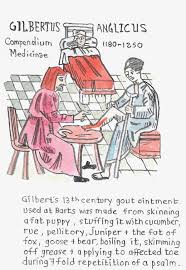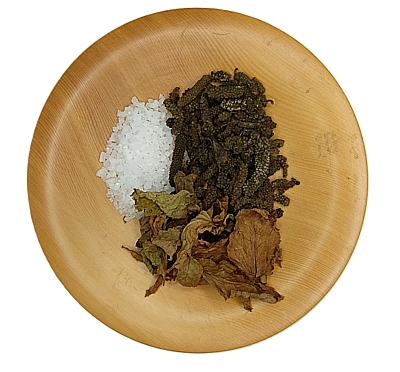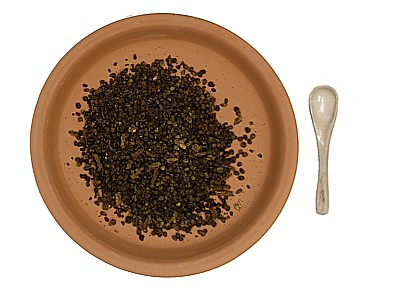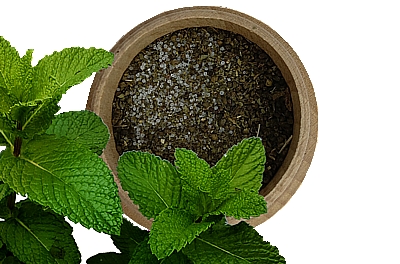|

back
experimental
archaeology
the
Trotula's
hair powder
Bancke's
tooth
powder
Hildegarde
von Bingen's
mouthwash
the Trotula's
tooth powder
Gilbertus Anglicus's breath freshener
|

Experimental
archaeology
Gilbertus Anglicus breath freshener
Making and
testing recipes for skincare and health from medieval manuscripts.
A breath freshening powder to chew and then swallow from Gilbertus
Anglicus

 GILBERTUS
ANGLICUS, GILBERTUS
ANGLICUS,
Compendium of Medicine,
Wellcome MS 537
England. about 1400 A.D.
"And let him use this powder:
Take of pepper, one ounce;
and of mint, as much;
and of rock salt, as much.
And make him to chew this powder
a
good while in his mouth,
and then swallow it down."

 I
have recreated this powder to use in my MEDIEVAL
BATH DISPLAY and have included a step by step guide to my
approach, including my expectations and how it really worked out. I
have recreated this powder to use in my MEDIEVAL
BATH DISPLAY and have included a step by step guide to my
approach, including my expectations and how it really worked out.
The
prep:
There were a number of things
to think about before I started.
- Where can I get the ingrediants?
- Drying the ingredients or buying them pre-powdered or using
them fresh?
- Air dry or oven dry the grown ingredients?
- How much of which ingredients should I use?
- Will it actually make any real difference?
- How long will it last?
- Do any of the plants have benefits associated with them which
make them particularly useful?
|

What
you need:
Ingredients
1 oz Rock Salt
1 oz Pepper
1 oz Mint
Kitchen things
Spoon
Small scales
Bowl for mixing
Mortar and pestle for powdering

|

|
 |
Rock Salt 1 ounce
This is easy to find
and purchase and is very cheap. Rock salt can be bought
from any supermarket or grocery shop.
|
 |
Pepper 1 ounce
This can be bought
from most Asian or Indian supermarkets. Gilbertus doesn't
specify what type of pepper to use, but long pepper was
the commonly used one in the Middle Ages.
Both long pepper
and black pepper were used in Roman Britain, so I've chosen
long pepper for this recipe. It is a sweeter pepper than
black pepper.
This image is long
pepper, half ground down.
|
 |
Mint 1 ounce
Fresh leaves or dried
leaves? The recipe doesn't say, but I feel like dried
leaves would powder down better than fresh ones, so I
am using dried mint leaves from my own herb garden.
|
|
|
Mortar and pestle
I have a really great
stone set which is sturdy enough to work well on most
substances.
|

Step by
step:
1. Weigh and measure out the ingredients. In this case, the
exact amounts are given, so it's just about deciding how big
a finished quantity you want to make and weighing out the
same weight for each of the mint, salt and pepper.
2. Using the mortar and
pestle, grind the ingredients to a powder. I did these one
at a time.
3. Mix them together.
No other steps are needed for this.
The resultant powder
smells a little peppery and a little minty.
 The
results: The
results:
The taste really is interesting.
This was a journey of great
discovery, where I discovered: Less is more of some things and
I'm surprised at the one to one to one ratio.
I expected this to work because
of the mint, and expected a minty taste, when in fact, the overriding
taste was the sweet pepper, which did, in fact freshen the breath.
The mint was barely noticable and while the salt was very... salty,
it did provide an abrasive quality which would have worked on
teeth.
Overall, this recipe did
work. My mouth felt refreshed for an extended amount of time,
although quite peppery. The salt taste faded reasonably quickly,
and the mint likewise. The end result is a positive. It is palatable,
and it works.

The
audience results:
This has yet to be
tested in my circle of friends. Results will follow.

|



 GILBERTUS
ANGLICUS,
GILBERTUS
ANGLICUS,  I
have recreated this powder to use in my
I
have recreated this powder to use in my 




 The
results:
The
results: 